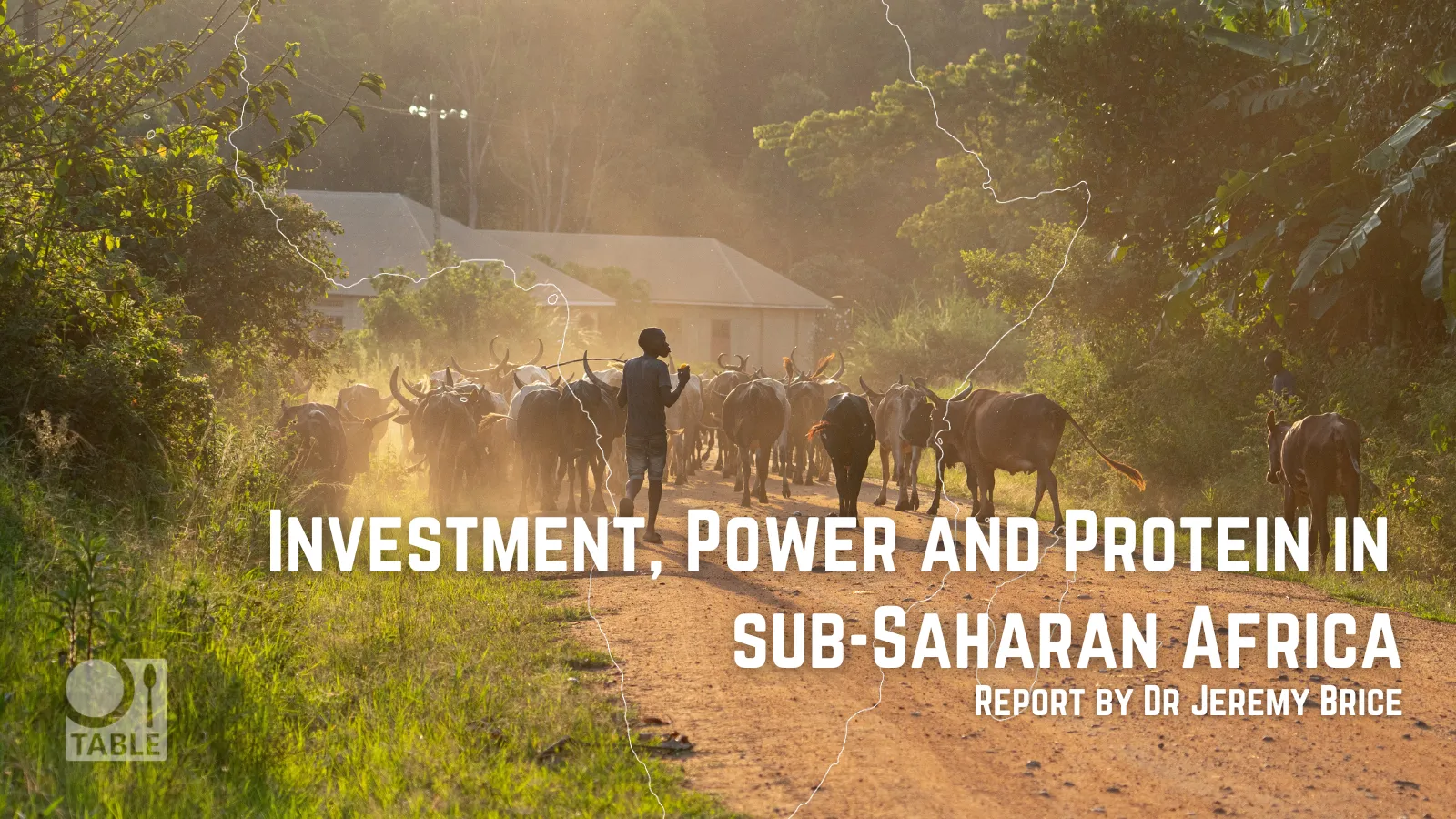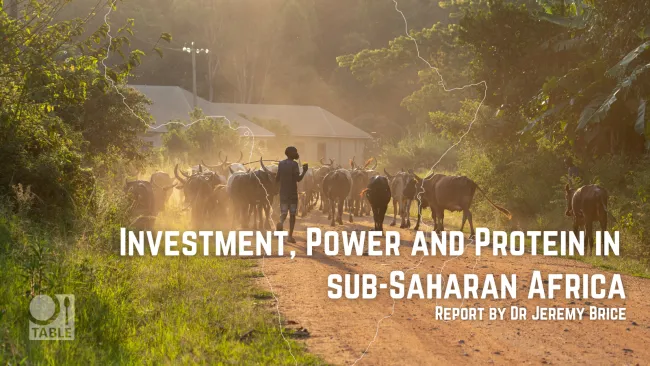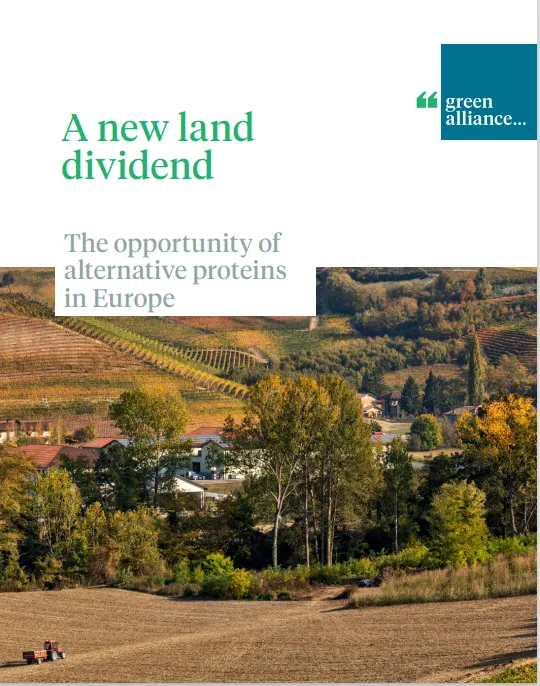Phase 1: Desk Research
The research presented in this report was conducted in two phases. During the first phase, the author conducted a rapid review of publicly available reports and statistics with the aim of assessing which groups of investors provide the largest quantities of financing to protein production in sub-Saharan Africa and of establishing how much each group invests. Academic publications relevant to agricultural investment in sub-Saharan Africa were identified through structured searches of the Scopus and Google Scholar databases. Meanwhile, relevant reports were identified through searches of the websites of relevant international food policy actors (e.g. the FAO, WHO and UN Development Programme), development finance institutions (such as the World Bank and the African Development Bank) and financial industry organisations (such as the Emerging Markets Investors Alliance and Global Impact Investing Network).
The author identified datasets relevant to investment in protein production in sub-Saharan Africa through examining the original sources of data used in the publications analysed during this initial literature review. While proprietary financial datasets were excluded from further consideration due to budgetary restrictions, this stage of the research identified the following publicly available data sources as holding quantitative financial data relevant to this research project:
- The UNFAO’s FAOSTAT platform (which provides country-level data on government spending, Overseas Development Assistance (ODA) funding and commercial credit provided by the banking sector to the Agriculture, Forestry and Fishing sector).
- The OECD’s Creditor Reporting System (which provides data on the quantities of ODA funding provided to the agricultural and fisheries sectors of eligible countries by Development Finance Institutions, philanthropic organisations and the governments of OECD Member States).
- The OECD’s Producer Support Estimate (PSE) database (which provides comparable data on the monetary value derived by agricultural producers from the government agricultural policies of countries across the world).
Descriptive analysis of these publicly available datasets was carried out in order to ascertain which broad categories of public, private and third sector actors are most prominently involved in financing agricultural production in sub-Saharan Africa. This analysis addressed our first research question by establishing which groups of investors commit the largest quantities of finance to sub-Saharan Africa’s agriculture, forestry and fisheries sector and by exploring (where possible) what proportion of their investment is devoted to the animal protein sector. The results of most elements of this initial phase of desk research are presented in Chapter 4, although the results of the analysis of the PSE database are presented separately Chapter 6.
However, the understanding of the landscape of investment in African protein production provided by this analysis of publicly available quantitative data was subject to several important limitations. First, very little data on private sector investors’ role in financing protein production within the region is publicly available – making it difficult to assess the scale and nature of their role within the wider agricultural investment landscape. Second, while the desk research conducted during the first phase of the project provided a broad overview of who finances protein production in sub-Saharan Africa, it provided relatively little information about which protein sources and production systems different actors invest in. Finally, analysis of statistical data alone provides little insight into the financial or normative goals which motivate these investors to finance protein production in sub- Saharan Africa or the theories of change which make them believe that their investments will help to bring about these goals.
Phase 2: Expert Interviews
In order to address these limitations of this initial desk research, the author undertook a second phase expert interview research. Building on Littig’s (2009: 100) characterization of an expert interviewee as a person “who is responsible for and has privileged access to the knowledge of specific groups of people or decision-making processes”, interviews were sought with individuals possessing a detailed understanding of the motives and investment decision making processes of organisations which finance protein production in sub-Saharan Africa (Robinson, 2021).
Nineteen of these expert interviews were carried out between January and March 2022. Some interviewees held professional roles which involved them directly in the investment decisions of organisations identified through desk research as key funders of protein production in sub-Saharan Africa. Others (e.g. employees of research organisations, agricultural development consultants and employees of NGOs which assist African producer organisations in gaining access to finance) were able to provide insight into broader differences and similarities between the motivations of various investors in African protein production due to longstanding professional links with multiple agricultural development funders. Both groups of interviewees were judged to possess extensive knowledge both of the expectations about the future held by key investors and of the processes through which these expectations informed their financial decisions.
Interviewees were recruited through a combination of snowball sampling and emails to key figures within organisations identified through desk research as having invested in protein production in sub-Saharan Africa (whether through grants, loans or direct equity holdings in African protein production enterprises). In keeping with the norms of expert interview research (Littig, 2009) this project adopted a purposive sampling strategy, with interviews continuing until the sample included representatives of all but two of the major groups of investors in African agriculture identified during the desk research phase. National governments were excluded from the interview sample because no single government’s investment priorities are likely to be relevant across the entire sub-Saharan African region. By contrast, the author attempted to secure interviews with representatives of multinational meat and dairy companies with operations in sub-Saharan Africa, which might be expected to act as providers of foreign direct investment. However, none were willing to contribute to the project, perhaps because such investments are commercially and/or reputationally sensitive for these firms.
Due to time and budgetary constraints the number of interviewees representing each of the remaining group of investors remains small, and the findings of the interview study should not be assumed to be either exhaustive or statistically representative of the wider population of investors in protein production in sub-Saharan Africa (Bernard, 2006). The interview sample comprised:
Two interviewees were located in West Africa, one was based in Southern Africa, six were based in East Africa, and the remaining ten interviewees were located in Europe and North America (although most had worked extensively in sub-Saharan Africa in previous roles).
Once interviewees had been recruited, the researcher conducted semi-structured interviews which ranged in duration from approximately 30 minutes to 90 minutes and took place over video chat platforms such as Zoom, Microsoft Teams or Google Meet. The precise list of questions posed during each interview was tailored to reflect the characteristics of the interviewee’s organization and of their role within it, questions were posed in an open-ended format in order to allow interviewees to answer in their own terms, and interviewees were given opportunities to highlight any additional topics which they felt should be discussed. Each of these interviews was recorded and transcribed, with the transcripts subsequently coded and analysed using NVivo 12.
In order to maintain the anonymity of research participants, the names of the individuals and organisations which contributed to this research have been withheld and no information which might identify a specific organisation is reproduced in this report. All materials containing the names of these individuals and organisations, and the details of their responses to interview questions, have been stored exclusively on secure servers maintained by the University of Oxford in order to ensure that they are accessible only to the researcher.
Open coding was initially used to identify topics (or ‘themes’) which recurred across different transcripts (Bernard, 2006). This enabled the author to compare different interviewees’ accounts of matters such as the goals and intended beneficiaries of investment in sub-Saharan Africa, the ways in which investors’ aspirations informed their decisions to finance (or avoid) specific protein products or value chains, and the expectations and theories of change which motivated their investment decisions. Further analysis of the similarities and variations between different interviewees’ positions on various themes enabled the author to identify three distinct groups of investors, each of whose investment decisions were guided by a different ‘vision’ for the future of protein in sub-Saharan Africa. These visions, and the broader results of the interview research conducted during phase 2 of the project, are presented in Chapter 5.





Comments (0)